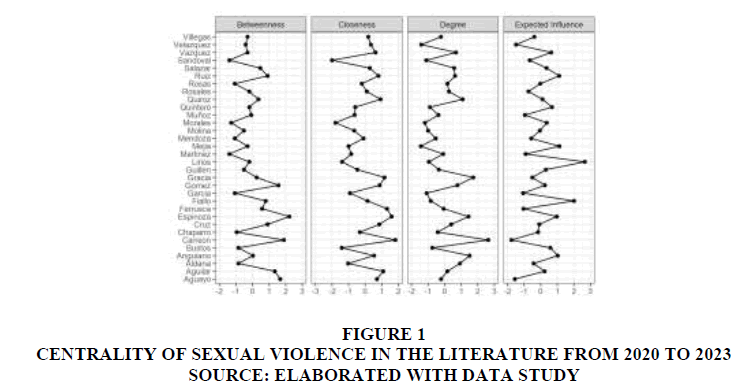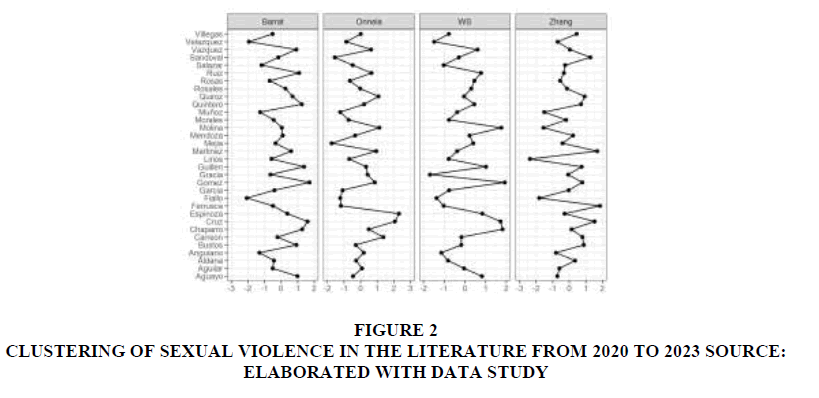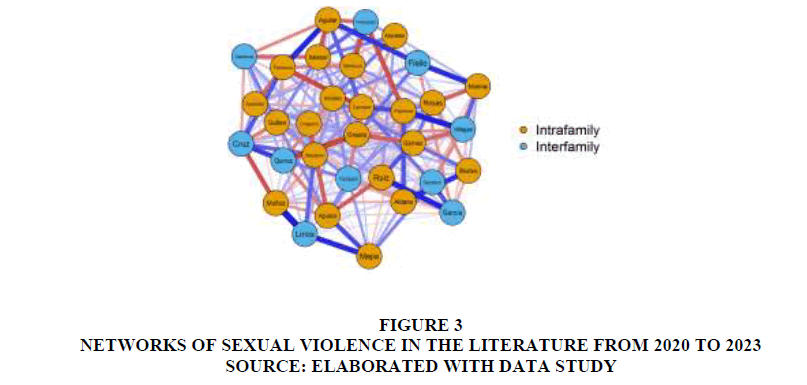Research Article: 2023 Vol: 26 Issue: 5
Network of sexual violence in the literature from 2020 to 2023
Rosa Marra Rincon Ornelas, University of Sonora
Javier Carreon Guillen, Autonomous University of Mexico State
Felipe de Jesus Vilchis Mora, Autonomous University of Mexico State
Cruz Garcia Lirios, School of Public Administration
Citation Information: Ornelas, R.M.R., Guillen, J.C., Mora, F.J.V., & Lirios, C.G. (2023). Network of sexual violence in the literature from 2020 to 2023. Journal of Legal, Ethical and Regulatory Issues, 26(5), 1-07.
Abstract
The discussion and specification of a model for the study of reproductive choice was the objective of the present work. A documentary study was conducted with an intentional selection of sources indexed to Dialnet, Latindex, Publindex, Redalyc and Scielo from 2020 to 2023. The relationship between the calculation of costs and benefits with risk behaviors was established, although the design of the investigation limited the discussion with the literature consulted, suggesting the extension of the work based on the information published in Copernicus, Ebsco, Scopus and WoS.
Keywords
Sexual Health, Reproductive Health, Rational Choice, Termination of Pregnancy.
Introduction
The relationship between reproductive rights, centered on the decriminalization of abortion and freedom of choice over one's own body, with respect to the self-management and administration of financial resources oriented to subjective well-being is demonstrated (Ajzen, 2001). Since the 1970s, rape as an aggravating abortion was a probable cause in the decriminalization of those who requested the assisted termination of pregnancy, but public health policies in general and reproductive health in particular did not allocate sufficient funds for the equipment, promotion and medical assistance in the bulk of the population until the late eighties (Ajzen et al., 2011).
The concept of reproductive autonomy is crystallized in 130,824 cases of assisted interruption, 7,653 in minors, 73% of the cases were requested by residents of Mexico City, 24% of the State of Mexico and 3% of other entities (Ajzen & Fisbbein, 1974). Regarding the cases in which the request was made, but did not attend the assisted interruption session, they represented only 13.5%. 83% of requests and interruptions were from people whose age range is between 18 and 35 years and only 4% of cases have been made more than once (Ajzen, 2011). Regarding the levels of education, 8.3% only finished primary school, 32.9% finished secondary school, 17.2% studied a higher level, 0.4% a technical level and 1.7% did not He mentioned some level of education(Cabezas-Garcia et al., 1998).
The objective of this paper is to discuss the theoretical, conceptual and empirical frameworks around freedom of choice and with respect to the sexual and reproductive rights of female heads of family entrepreneurs, specific case of merchants of coffee products and services.
Formulation. Will there be differences between the axes, themes and categories of the research agenda on reproductive sexuality in a review period from 2010 to 2020?
Null hypothesis. There are differences between the axes, themes and theoretical categories reported in the literature consulted on reproductive sexuality in a review period from 2010 to 2020.
Method
Design: A documentary study was carried out with a sample of indexed sources in repositories in Latin America - Dialnet, Publindex , Latindex , Redalyc and Scielo - during the period from 1961 to 2020.
Instrument: Matrices of content analysis and opinions about reproductive sexuality, considering the Delphi technique in three phases; Qualifying, feedback and consensual.
Process: The criteria for searching for information by keywords; freedom of choice, sexual and reproductive rights, heads of household and entrepreneurship. The document will serve to establish the topics and axes of discussion on the agenda, as well as to discuss the scope and achievements in order to specify a model for systematic research of the problem and balance and prospective scenarios.
Analysis: Descriptive, contingent and proportional parameters were estimated in order to observe the tendency of the axes, themes and categories on reproductive sexuality.
Results
In the first phase of analysis or qualification of the findings reported in the literature by the experts on the subject, the category of "commitment" prevails. This is because the literature directly relates to the couple's decision regarding sexuality, procreation and parenting with commitment. In this way, if the couple perceives a commitment to the relationship on the part of their counterpart, then they will build a common future. Otherwise, when the commitment is not felt, one of the interested parties will delegate the decision responsibility to its counterpart (see Figure 1).
The discrepancy between the judges is reduced in the second feedback phase where the opinions conform to a common criterion of commitment in the couple. In this sense, sexuality is discussed as a power relationship whenever a couple's commitment prevails and as part of a process of violence when the commitment does not prevail (see Figure 2).
Figure 2: Clustering Of Sexual Violence In The Literature From 2020 To 2023 Source: Elaborated With Data Study.
In the third consensual phase, the judges who are experts in the field of couple violence assume a unique position regarding the influence of the reference group on the couple and the group to which they wish to belong. This is how reproductive sexuality, in the dimension of lack of commitment, can make its decisions and carrying out its actions based on the influence of the closest group such as family or friends (see Figure 3).
Discussion
The contribution of the present work to the state of the matter lies in the discussion and specification of a model for the study of reproductive choice, although the design of documentary research suggests the extension of the model based on the consultation of literature in repositories such as Copernicus, Ensco, Scopus and WoS.
Aristotle's theory of happiness (384-322 BC) states that there is a close link between happiness and rationality. In such a relationship, the reasoning abilities correspond to the choice. In this sense, the rational and free individual will be the one who pursues happiness by calculating their goals, achievements and expectations that make up a virtuous circle of continuous learning and knowledge, as well as a constant review of the scope and limits of the abilities of thinking, reasoning, planning and systematization (Saldana & de los Godos, 2009).However, the Aristotelian approach avoids the need and motivation factors as drivers of human relations between individuals who share objectives and synchronize capacities aimed at achieving their expectations (Chavez et al., 2009). Humanist theory maintains that it is human relationships that determine the purposes, goals and tasks or collaborations between those who show a legitimate interest in mutually benefiting.
In this way, humanist theory, unlike Aristotelian thought, warns that the sum of wills and efforts is more significant than the high reasoning capacity of an individual (Fernandez, 2010). One aspect of humanism is in the pyramid hierarchy of needs and motivations of Maslow who points as the basis of any personal relationship to the needs of scarcity or deficit, those that derive from the lack of training and the absence of constant motivation.
Next, the physiological needs that allude to the feeding and maintenance of the organisms and, consequently, suppose features of disease and accident prevention, performance and productivity enhancers (Garcia et al., 2003). If efficiency, effectiveness and effectiveness are determined by good nutrition and maintenance of brain neurons, then safety needs allude to the perceptions of individuals. In this sense, the risks and threats expected in the face of an immeasurable and unpredictable event in its consequences imply a system of constant monitoring of crime and violence prevention strategies and styles.
Therefore, security opens the expectation of belonging or categorization and identity to a reference group or to another group to which one wants or wants to belong (Gonzalez Galban, 2000). Security needs, focused on prevention and protection, even in the claim, are antecedents of attachment and care of an environment in which the closest people are valuable for being part of the individual's security scheme (Lara, 1987). Once people congregate and develop their interpersonal relationships, they feel the need to encourage their affections and emotions (Ramirez, 2000). This is the case of the relationship between rulers and governed with respect to a security project. In this way, recognition is outlined as a first order need once all the exposed ones have been satisfied.
Transcendence, according to Maslow's theory, is the goal of the needs and the maximum achievement of the capacities driven by motivational systems (Salazar, 2007). It is needs to be more than of having, of mind or of belonging (Serrano, 2011). However, the freedom of choice to be present in each of the needs, at the same time to carry out the actions and implement the capabilities, seems to be determined by a social and ideological structure that would determine their hierarchy (Tapia et al., 2008). Therefore, freedom of choice seems to be rather transitory and applicable at times and circumstances in which a decision is made not entirely deliberate or convincing.
In the case of the full exercise of sexual and reproductive rights, theories of freedom of choice only contextualize the possibilities based on the priorities of the individuals, circumventing ideological and social mobilization issues such as sexuality and disruption assisted unwanted or unplanned pregnancy. Classer's rational choice theory considers that individuals behave as agents that compete in an economic system for resources or are actors that a political system defines the strategies of action and mobilization with the intention of carrying out a conflict and a change of social or collective dimension.
Reproductive rights are, in the first instance, represented by a sector of the population as a support instrument for an unwanted pregnancy or in any case compromises the plans of the woman involved (Caponi, 1997). In this sense, social representations or the objectification, anchoring and naturalization of beliefs, perceptions, motives, attitudes and intentions of cases occurred, current events and future scenarios in which the management and administration of resources play an important role, often occur essential and central in the decision making process when requesting and assisting an assisted interruption of pregnancy .
Even such a decision assumes a series of expectations that are determined by the information available regarding the risks of requesting and carrying out the assisted interruption (Greco, 2008). It is a freedom of choice limited by the rights of third parties. Stuart Mill proposed that freedom is a determinant of the election, but if it involves third parties, then it is the choice that affects freedom (Canguilhem, 2004). In the opposite case, when freedom generates elections that inhibit the rights of third parties, progress is asymmetric (Contandriopoulos, 2006). If there is more consensus liberties and d and elections, then progress is embodied in a representative democracy. Consequently, freedom is divided into thought and action or instrumentalism.
The reflection of the environment can be unlimited, but the intervention in its processes is limited by the rights of third parties (Seth & Goldsmith, 1975). These are ethical principles that are intended to regulate human relationships, the establishment of their objectives, and the instrumentation of their abilities and the achievement of their goals. The choice and partner, sexual and reproductive depends on the expectation of relationship whenever the couple succeeds in establishing their decisions based on the degree of commitment to the relationship, but if not, then the Choice will depend on people close to the couple as is the case of the mother.
In the present work it has been highlighted that the choice of couple follows the guidelines of the rational decision making in which the costs and benefits establish a criterion to follow (Bunton at al., 1992). The reproductive choice is rather quilted by perceptions of aversion to disease prevention, propensity to risk behaviors and aversion to a healthy future, suggesting that sexuality is an emerging phase of risky lifestyles.
In the present study a continuum is established that goes from the freedom of choice to the restorative action that self-care implies, which has been conceptualized as a reaction to contingencies and risks (Greco, 2005). The termination of pregnancy is not the result of a rational, deliberate, planned and systematic choice since it is rather the product of the combination of cultural and cognitive factors.
In the present work, the reproductive choice has been discussed as part of a valuation and normative corpus focused on costs and benefits, but in relation to a reference and membership group. It is a complex decision process in which interpersonal relationships are conditioned by subjective and intersubjective norms, as well as by the dispositions towards the relationship and the commitment of loyalty and fidelity.
Conclusion
The study of the reproductive choice, defined as the balance of the requirements of the environment with respect to the freedoms, needs, motivations and capacities of management and consensus can be carried out following the logical trajectories of the relationships between the variables used in the theoretical framework and Fenced conceptually.
In the model, the freedoms of choice are determinants of the motives that everyone develops in his eagerness to establish the differences with respect to the needs. From the Aristotelian perspective, the link between freedoms and happiness is in the capacities, but from Maslow's view, it is the needs that mediate the relationship between freedoms and elections. Therefore, an election will be defined by the hierarchy of human needs, although the reasons are inherent to the needs, the freedoms of choice separate the needs from the reasons for establishing the limits of the individual process with respect to a process collective.
Consequently, skills are factors that from the point classeriano define rational choices of actors and agents rather than individuals or groups. It is assumed that the election process reflects a context of scarcity and competition for resources. Therefore, a greater capacity for processing and assimilation of freedoms implies the hierarchy of needs and the delimitation of the reasons for carrying out an election.
However (hypothesis 4), the observation and anticipation of the reproductive choice is different from a rational choice based on costs and benefits, or, different from a consensus based on the availability of information, deliberation and agreements or co-responsibility. . It is primarily the result of the influence of freedoms and their regulation on needs, motives and capabilities. In other words, freedom of thought and freedom of action, as stuartmillist theory says, are two factors that can be integrated into the model to explain a choice of reproductive type.
References
Ajzen I. (2001).Nature and operation of attitudes. Annual Review Psychology, 52, 27-58.
Indexed at, Google Scholar, Cross Ref
Ajzen, I., & Fisbbein, M. (1974). Factors influencing intentions and the intention-behavior relation.Human relations,27(1), 1-15.
Indexed at, Google Scholar, Cross Ref
Ajzen, I., Joyce, N., Sheikh, S., & Cote, N.G. (2011). Knowledge and the prediction of behavior: The role of information accuracy in the theory of planned behavior.Basic and applied social psychology,33(2), 101-117.
Indexed at, Google Scholar, Cross Ref
Ajzen,I. (2011). Job satisfaction, effort, and performance: A reasoned action perspective.Contemporary Economics,5(4), 32-43.
Indexed at, Google Scholar, Cross Ref
Bunton, R., Tannahill, A., & Macdonald, G. (1992). Health Promotion-discipline and diversity.Edited by: Bunton R, MacDonald G. London, Routledge.
Indexed at, Google Scholar, Cross Ref
Cabezas-Garcia, E.,Langer-Glass, A., Alvarez-Vazquez, L., & Bustamante, P. (1998). Perfil sociodemografico del aborto inducido.Salud publica de Mexico,40(3), 264-271.
Indexed at, Google Scholar, Cross Ref
Canguilhem, G. (2004).Escritos sobre la medicina. Buenos Aires: Amorrortu..
Caponi, S. (1997). Georges Canguilhem and the epistemological status of the health concept. History, Sciences, Health-Manguinhos, 4, 287-307.
Chavez, M., Petrzelova, J., & Zapata, J. (2009). Actitudes respecto a la sexualidad en estudiantes universitarios.Enseñanza e investigación en psicología,14(1), 137-151.
Contandriopoulos, A.P. (2006). Elements for “topography" of the concept of health. Ruptures, Interdisciplinary Journal of Health, 11 (1), 86-99.
Fernandez Lopez, M.I., Carrillo Navarro, F., Leal Hernández, M., Carrillo Canaveras, I., Carrillo Navarro, E., Lozano Sánchez, M.L., & Pastor, L.M. (2010). An approach to abortion and immigration in Spain. The socioeconomic value of human life. Bioethics Notebooks: Official Journal of the Spanish Association of Bioethics and Medical Ethics, 21(73), 313-26.
Garcia, S.G., Lara, D., & Goldman, L. (2003). Knowledge, attitudes and practices of Mexican physicians regarding abortion: results of a national survey. Medical Gazette of Mexico, 139(s1), 91-102.
González Galbán, H. (2000). Theoretical aspects for the sociodemographic study of adolescent pregnancy. Northern border, 12(23), 65-85.
Greco, M. (2008). On the art of life: a vitalist reading of medical humanities. The Sociological Review, 56(2_suppl), 23-45.
Greco, M. (2005). On the vitality of vitalism.Theory, Culture & Society,22(1), 15-27.
Indexed at, Google Scholar, Cross Ref
Lara, H. (1987). Primicias socioculturales, planificación familiar y aborto. Revista Sonorense de Psicología, 1: 26-36.
Ramirez, C. (2000). Knowledge and attitudes towards sexuality in secondary education teachers.Sonoran Journal of Psychology,13, 47-54.
Salazar, H. (2007). Behaviors, knowledge and attitudes of adolescent students from urban areas of cities towards contraceptive methods. Journal of Heredian Psychology, 2, 34-44.
Saldana, J.P.C., & de los Godos Urcia, L.A (2009).Couple and group factors related to induced abortion in adolescent women.UCV-Scientia,1(1), 110-115.
Serrano, M. (2011). Knowledge, attitude and perception of the resident doctors of gynecology and obstetrics of the ISSSTE about emergency contraception.Journal of Surgical Medical Specialties,16, 215-220.
Seth B., Goldsmith S.B. (1975). The status of Health Status Indicators. Health Service Reports, 87(3): 212-220.
Indexed at, Google Scholar, Cross Ref
Tapia, A., Villasenor, M., & Nuño, B. (2008). Knowledge and attitudes towards the use of emergency contraception in university students.Medical Journal of the Mexican Institute of Social Security,46, 33-41.
Received: 09-June-2023, Manuscript No. JLERI-23-13683; Editor assigned: 12-June-2023, Pre QC No. JLERI-23-13683(PQ); Reviewed: 27-June-2023, QC No. JLERI-23-13683; Revised: 15-July-2023, Manuscript No. JLERI-23-13683(R); Published: 26-July-2023


